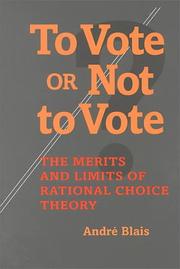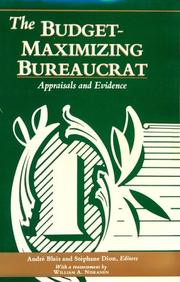| Listing 1 - 10 of 41 | << page >> |
Sort by
|

ISBN: 0822957345 0822941295 9780822941293 9780822957348 9780822990550 0822990555 1306553792 9781306553797 Year: 2000 Publisher: Pittsburgh, Pa. University of Pittsburgh Press
Abstract | Keywords | Export | Availability | Bookmark
 Loading...
Loading...Choose an application
- Reference Manager
- EndNote
- RefWorks (Direct export to RefWorks)
What makes people decide to vote? In addressing this simple question, André Blais examines the factors that increase or decrease turnout at the aggregate, cross-national level and considers what affects people's decision to vote or to abstain. In doing so, Blais assesses the merits and limitations of the rational choice model in explaining voter behavior. The past few decades have witnessed a rise in the popularity of the rational choice model in accounting for voter turnout, and more recently a groundswell of outspoken opposition to rational choice theory. Blais tackles this controversial s
Rational choice theory --- Voting --- #SBIB:011.AANKOOP --- #SBIB:324H42 --- #SBIB:32H3 --- Balloting --- Polls --- Elections --- Politics, Practical --- Social choice --- Suffrage --- Politieke structuren: verkiezingen --- Politieke wetenschappen: inleidende werken, handboeken, methoden --- Rational choice theory. --- Voting. --- Vote --- Choix rationnels, Théorie des --- Government - General --- Law, Politics & Government --- Political Institutions & Public Administration - General --- Théorie du choix rationnel --- Sciences politiques --- Elections et referendum
Book
ISBN: 9780199539390 0199539391 Year: 2008 Publisher: Oxford : Oxford university press,
Abstract | Keywords | Export | Availability | Bookmark
 Loading...
Loading...Choose an application
- Reference Manager
- EndNote
- RefWorks (Direct export to RefWorks)
Representative government and representation. --- Proportional representation. --- Elections. --- Politics, Practical. --- Gouvernement représentatif --- Représentation proportionnelle --- Elections --- Politique --- Representative government and representation --- Proportional representation --- Politics, Practical --- Gouvernement représentatif --- Représentation proportionnelle --- Élections --- Partis politiques
Book
ISBN: 1281853240 9786611853242 0191561568 Year: 2008 Publisher: Oxford ; New York : Oxford University Press,
Abstract | Keywords | Export | Availability | Bookmark
 Loading...
Loading...Choose an application
- Reference Manager
- EndNote
- RefWorks (Direct export to RefWorks)
First past the post is one of the oldest and simplest electoral systems. The logic is simple: the candidate with the most votes wins. It is the system in place in some of the oldest democracies, most especially the United States and the United Kingdom, as well as the largest democracy, India. This is also a system that is hotly debated, and proposals for reform are often advanced. This book addresses the following questions: What fosters or hinders reform of first past the post? When and why does reform emerge on the political agenda? Who proposes and who opposes reform? When and why do reform
Representative government and representation. --- Proportional representation. --- Elections. --- Politics, Practical. --- Electoral politics --- Mass political behavior --- Political behavior --- Politics --- Practical politics --- Political science --- Political participation --- Franchise --- Polls --- Politics, Practical --- Plebiscite --- Political campaigns --- Representative government and representation --- Cumulative voting --- Representation, Proportional --- Voting, Cumulative --- Constitutional law --- Elections --- Parliamentary government --- Political representation --- Representation --- Self-government --- Constitutional history --- Democracy --- Republics --- Suffrage
Book
Year: 1966 Publisher: Trois-Rivières: Ed. du Bien Public,
Abstract | Keywords | Export | Availability | Bookmark
 Loading...
Loading...Choose an application
- Reference Manager
- EndNote
- RefWorks (Direct export to RefWorks)
Maturation (Psychology) --- Mind and body --- Sex (Psychology)
Book
ISBN: 0822985322 Year: 1991 Publisher: University of Pittsburgh Press
Abstract | Keywords | Export | Availability | Bookmark
 Loading...
Loading...Choose an application
- Reference Manager
- EndNote
- RefWorks (Direct export to RefWorks)

ISBN: 0822936798 Year: 1991 Publisher: Pittsburgh University of Pittsburgh
Abstract | Keywords | Export | Availability | Bookmark
 Loading...
Loading...Choose an application
- Reference Manager
- EndNote
- RefWorks (Direct export to RefWorks)
Bureaucracy --- Expenditures, Public --- Representative government and representation --- Niskanen, William A.,
Book
ISBN: 9780199596720 0199596727 Year: 2012 Publisher: Oxford ; New York : Oxford University Press,
Abstract | Keywords | Export | Availability | Bookmark
 Loading...
Loading...Choose an application
- Reference Manager
- EndNote
- RefWorks (Direct export to RefWorks)
Political parties --- Political leadership --- Cabinet system --- Elections --- Partis politiques --- Leadership politique --- Cabinet --- Political sociology --- United Kingdom --- Ireland --- Canada --- New Zealand --- Australia
Book
ISBN: 9780774862677 9780774862691 0774862696 077486267X Year: 2020 Publisher: Vancouver: UBC press,
Abstract | Keywords | Export | Availability | Bookmark
 Loading...
Loading...Choose an application
- Reference Manager
- EndNote
- RefWorks (Direct export to RefWorks)
"Elections are at the heart of our democracy. Understanding citizens' decision to vote or to abstain in elections is crucial, especially when turnout is declining. In this book, André Blais and Jean-François Daoust provide an original and elegant model that explains why people vote, based on four factors: political interest, sense of civic duty, perceived importance of the election, and ease of voting. Their findings are strongly supported by empirical evidence from elections in five countries. The analysis is compelling and demonstrates the power of their model to provide a provocative and parsimonious explanation of voter turnout in elections."--
Elections --- Voting --- Voting research --- Political participation
Book
ISBN: 1550021362 Year: 1991 Volume: 17 Publisher: [Ottawa] : Commission royale sur la réforme électorale et le financement des partis,
Abstract | Keywords | Export | Availability | Bookmark
 Loading...
Loading...Choose an application
- Reference Manager
- EndNote
- RefWorks (Direct export to RefWorks)
Democracy --- Representative government and representation --- Elections --- Démocratie --- Gouvernement représentatif --- Elections --- Canada --- Canada --- Politics and government --- Politique et gouvernement
Book
ISBN: 2891720245 Year: 1995 Publisher: Québec La société des musées Québécois/Musée de la Civilisation
Abstract | Keywords | Export | Availability | Bookmark
 Loading...
Loading...Choose an application
- Reference Manager
- EndNote
- RefWorks (Direct export to RefWorks)
Museum exhibits --- Museum labels --- Museums --- Rhetoric --- Educational aspects
| Listing 1 - 10 of 41 | << page >> |
Sort by
|

 Search
Search Feedback
Feedback About UniCat
About UniCat  Help
Help News
News